 Facebook
Facebook
 X
X
 Instagram
Instagram
 TikTok
TikTok
 Youtube
Youtube
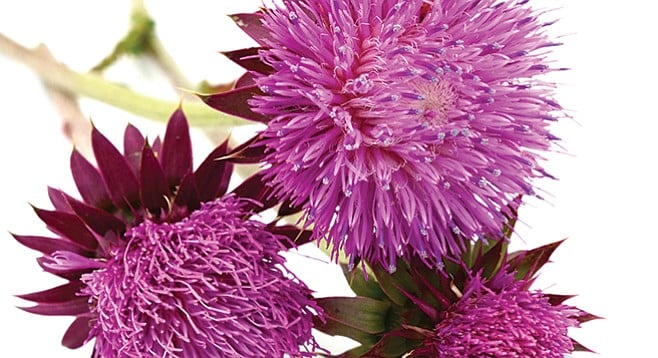
What exactly is an invasive plant, and why should we give a rotten rhizome if one crops up in our side yard?
Dan Gluesenkamp answers: “One widely accepted definition includes two components: It’s not native to the area, and it was brought here by humans since European settlement of California.” Nonetheless, Gluesenkamp, who directs the California Native Plant Society, says even a native plant can be considered invasive if it “spreads quickly and dominates its space.”
For some native flora advocates, the fight to eradicate invasive plants is tied to the ultimate mission of saving certain species from extinction. However, these botanists maintain that broader goals of ensuring what they term “biodiversity” (coupled with water conservation) are also compelling reasons to shun certain plants, large and small. For the average San Diegan, however, invasiveness is typically of scant concern unless and until it shades a Venn diagram that also includes the noxious factor.
I remember the first time I got up close and personal with the bull thistle. I didn’t know its name at the time and regarded it as just another spiny-stalked weed that grew fast and uninvited. In a cursory but sweaty effort to placate my wife, I’d been pulling out the most prominent offenders from our back yard, and although I wore leather gloves, the most-used fingertips had holes, which took the evil thistle no time to locate and penetrate. This left a middle finger (the irony of which escaped me at the moment) was impaled with thin, intensely stinging hairs, the devil’s acupuncture.
Several years later, during a dry winter, I resolved to clear the yard for good, laboring by hand to uproot the scented geraniums whose ambitious rhizomes had colonized half the space. I ripped, hacked, plucked, scoured, and extirpated until the plot was bare (albeit stony) earth in every direction. But I neglected to till the area. Beneath the surface, it was “don’t ask, don’t tell.” And I’d forgotten all about the invader whose name I still didn’t know.
Not a week later than I’d egged on my lumbar stenosis in the name of weed abatement, it rained. Of course it rained, just enough to trigger the robotic cautions of news-readers who, in lieu of acknowledging an intrinsically arid climate, are compelled to chant, “but the drought’s not over.” And up like thorny missiles went a battery of bright green stalks, some as high as the weathered six-foot fence. Soon after, each was topped by a bright off-lavender flower, a bristly crown, and I now knew the name of my tormenter—the bull thistle, Cirsium vulgare.
Setting aside for the moment my painful bull-thistle remembrances, I asked Gluesenkamp, a Berkeley PhD, to name some of San Diego’s finest…floral invaders. Turns out his familiarity with the least-wanted plants isn’t solely from the ivy-ensconced walls of academia.
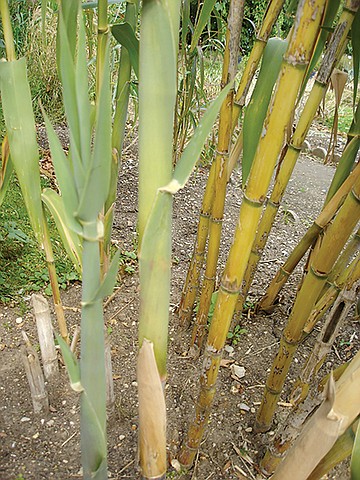
“You guys have some really good ones, including stuff I used to play in when I was a kid growing up in Fallbrook. A common one everyone knows — we used to call it ‘bamboo’ but it’s not actually a bamboo — it is Arundo donax; some people call it ‘giant cane’ or ‘giant reed.’ In Fallbrook where I grew up, it was always full of pot patches. It spreads quickly, drives out natives, causes fires.”
Arundo donax is but one member of a hit list whose prolific riparian juggernauts cause consternation, if not outright anger, among San Diego’s native-plant advocates. David Varner, resource management director for the San Elijo Lagoon Conservancy, echoes the extant orthodoxy whose focus is on wetlands ecosystems.
“The ones in waterways are the worst. The giant reed has an interesting history in that it was originally from South Asia and was brought to the Americas even before it was brought to Europe. People thought it might make a good fuel, thatch for roofing materials. Things weren’t necessarily done scientifically Plants were brought over and tested; they worked or they didn’t. Turned out that the giant reed wasn’t a great bio fuel. It doesn’t have a lot of energy in it; it’s fibrous, so it doesn’t burn very bright.”
Yet neither Varner nor any of his flora-focused colleagues are wont to condemn the builders of early San Diego for their antediluvian ways. “Almost all invasive plants were introduced intentionally for good purposes at the time. The world view was such that it seemed like a good idea: make the most of our resources, bring things from around the world. Take Pampas grass, for example. It was brought here for erosion control, to retain soils on steep slopes on sides of highways. This was a different time and people were looking for resources and ways to carve their livelihood out of this land.”
This brings us to the eucalyptus genus, whose blue gum and silver dollar variants are ubiquitous around the county and emblematic, if not downright iconic, in Rancho Santa Fe and Scripps Ranch.
“Finding a tree that did well here made sense. The railroad companies planted eucalyptus so they could use the wood for railroad ties.”
Some of the planned uses for imported plants might strike moderns as whimsical, even frivolous. Varner notes, “There’s a legend that some of the early missionaries, in order to connect the settlements visually, scattered mustard seeds, which were native to Spain; they formed a yellow path from one mission to another. Mustard seeds can germinate and grow in a wide variety of habitats, and they’re a problem in the county’s deserts.”
Where do the invaders fare best? “In any area of San Diego County,” answers Gluesenkamp, “you’ll find an invasive plant that’s going to succeed there. But the places that are the most invaded are along the coast, where there’s good fertile soil, milder weather conditions, better water availability — all the stuff you’d want for any plant. We’re most concerned about these areas, because the same conditions that make it a great place for invasive plants to live make it a great place for people to live.”
In essence, from a botanical standpoint, invasive plants aren’t keen on sharing.
“Because we’ve built up these desirable coastal areas, there’s not a lot of natural land left. The plants and animals that used to live there have smaller bits of habitat. Picture the canyons that are between the mesas in San Diego: each one is like its own little nature preserve. We’ve got endangered species hanging on in there, and whenever these places get invaded, there’s less of that habitat left to support the creatures that really need it.”
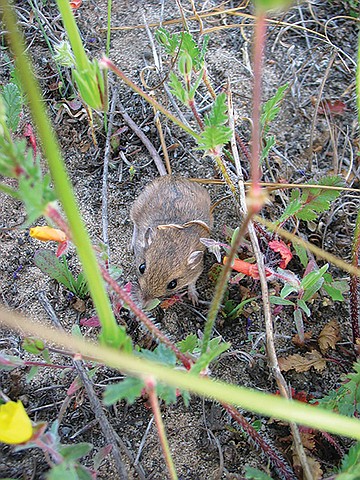
Wherever they’re situated, and whatever the reasons for their introduction, why does it matter if non-native plants thrive, even dominate, in San Diego? Aesthetic reasons aside, should locals lose sleep as giant cane evicts cottonwood, sycamore, and willow trees from riparian locales? David Varner replies, “Well, I am casting a value judgment, but as a scientist, I should ask, ‘Does it have a particular function or effect?’ Can native species live with it?’ Have they adapted to these circumstances?’ For example, there are birds that pass by San Diego twice a year, there are local snakes. There’s the Pacific pocket mouse, a little rodent. Maybe these are things that no one thinks about, but to me they’re important because they’re part of the biodiversity of San Diego County. Plants like Arundo and Pampas grass [Cortaderia selloana] form monocultures which push out other plants and displace our native species.”
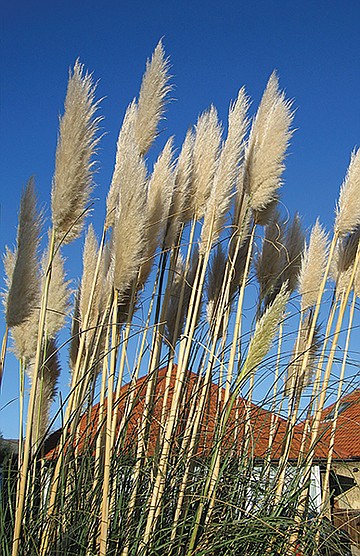
In the case of birds, such as the dwindling least Bell’s vireo —“A tiny bird that maybe no one cares about,” he laments — he maintains that it’s a case of ornithological disorientation. “The invasive plants don’t have similar vegetation structures [branches and leaves], so birds can’t make nests there. When the structure changes, they don’t know what to do.”
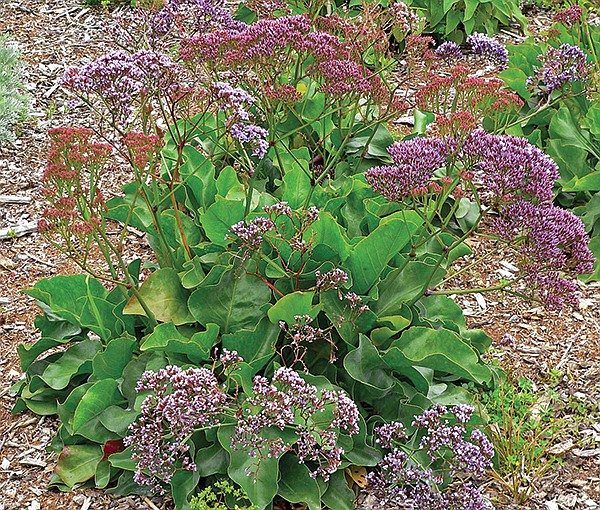
As seriously as some botanists view the incursion of non-natives in the county, there’s acknowledgment, not always grudging, that the invaders can be easy on the eyes. Dan Gluesenkamp comments, “There’s one that most people in San Diego will recognize, limonium, or sea lavender. If you’re driving on the 5 past the flower fields in Carlsbad, north to Oceanside, you’ll see this bluish-purple flower growing along the roadsides. There’s also another kind of sea lavender in the wetlands around Mission Bay. Sea lavender is one that you don’t have to be a botanist to recognize; they’re beautiful, nice, pretty flowers.”
But when it comes to aesthetics versus the hydrological cycle, David Varner sides with the natives. Take the Canary Island date palm, Phoenix cana. “It was brought over around 100 years ago for horticultural reasons because people thought they were pretty, but it affects our water supply because it consumes large amounts of water. The trunk acts like a stem that draws water up the trunk of the tree and then it evaporates into the atmosphere, so less water goes out into lagoons and lakes. It fruits prolifically and seeds end up in waterways like the Buena Vista Lagoon.” It’s in North County’s lagoons that, according to Varner, the Canary Island date palm wreaks the most havoc. “From the highway, you can’t see the small ones, but you can see the 30- to 50-foot-tall trees. In some spots the density is up to one tree per square meter.”
I ask: “So what if these palms [along with another import, the Mexican fan palm] increase local evapo-transpiration? Doesn’t it all eventually zero out in the hydrological cycle? And does the average San Diegan care about the hydrological impact? What’s the implication? I assume that the average non-scientist probably wouldn’t sit around worrying too much about evapo-transpiration, right?”
“Yeah,” admits Varner, “but he’d want that water to be available when he turns on the tap. It’s a precious resource and we want to be using it as efficiently as possible. When these trees are removed, the water table goes up.” Varner acknowledges that faster evapo-transpiration rates occasioned by non-natives like the imported palms would have no effect on local reservoir levels — San Diego’s principal water supply is the Colorado River — he maintains that county well water is diminished to some unmeasured extent.
Some of the county’s plant pests need no esoteric justification to be shunned. Gluesenkamp muses, “One that’s historically interesting is poison hemlock, which is fairly common in San Diego. Looks a little bit like anise, but anyone going to eat it will quickly realize it’s not the stuff we all chewed on as kids. This one stinks, and if you were to try it, it tastes terribly nasty, so it’s hard to understand how Socrates was able to choke down a whole mug of this stuff. That’s how Socrates was executed; he was forced to drink a chalice of poison hemlock juice. You can find it all over the place, such as, for example, any old waste area where you’d find something like fennel. It prefers sandy, wetter sites, disturbed soil; it’s fairly abundant.”
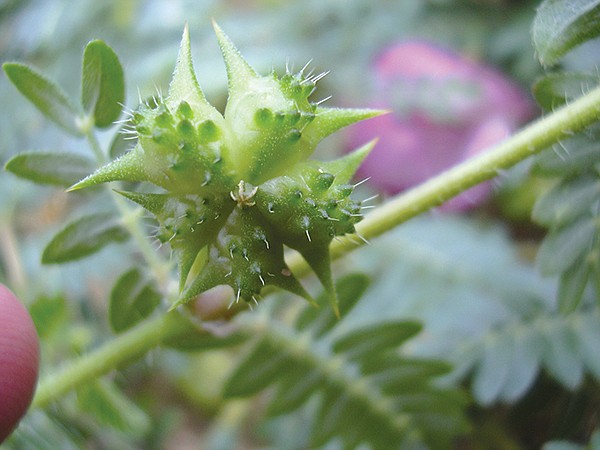
As for abundance, it turns out that San Diego County hosts more than its share of invasive plants that vex and annoy. David Varner opines, “It’s not always about what’s good for the native habitat. There are some plants that don’t do well with people. For example, let’s say the seed is in a shape that gets up a dog’s nose and causes an infection. And there are various cultural reasons we don’t like certain plants.” One standout, he says, is goat’s head, Tribulus terrestris (also called “puncture vine”) whose infamous seeds are in the shape of a goat head. “It has these thorns that’ll make you bleed. They pop tires, bike tires especially.” Where to find them around town? “They do well on bare ground that’s been disturbed; you’ll see them on the train corridors that run up and down the coast.” Noting the capacity of widely disdained pest-plant to adapt, Varner adds, “Goat’s head was very successful in traveling around the world and expanding its habitat, because whatever it punctured carried it to a new land and it did well.”
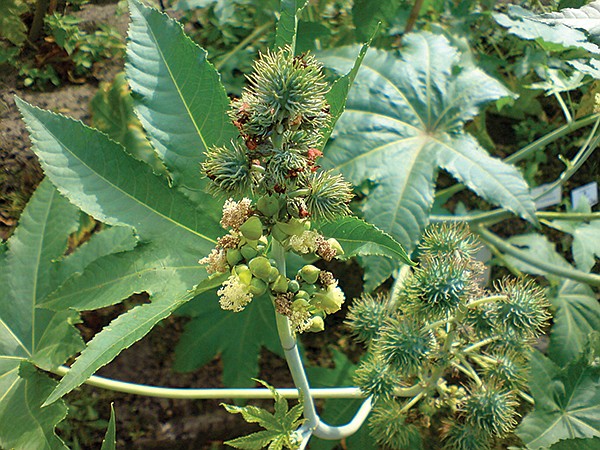
And don’t forget the castor bean plant, Ricinus communis, a native North African import whose showy beans yield the makings for ricin, along with a more mundane oil used in folk medicine and as an engine lubricant. It’s the “dark side of agriculture,” quips Varner.
Gluesenkamp approaches invasive plants in epidemiological terms. “In the 1800s in Europe, the biggest threat to human health was invasive species [of diseases] in a sense. As the great cities of Europe emerged, everyone was moving to the cities. There was high population density and mobility — perfect conditions to spread disease. It was just kind of accepted that great cities had great disease outbreaks; they didn’t really know what caused it, figured there wasn’t much you could do about it.”
Gluesenkamp regales me with the tale of Dr. John Snow, a London physician who made a cholera death map which showed that epidemic deaths were clustered around a certain well.
“They got curious, dug up the well, and found that the pipes in everybody’s outhouses led directly to the well. People were crappin’ in their water, getting everyone sick. That was the birth of epidemiology: early detection of things that are going to hurt us and then responding rapidly. Those tools are really a success in disease prevention, and if we can apply them to natural areas, then we can have healthy, diverse, abundant natural areas.”
Gluesenkamp says that a local battle against a prolific algae illustrates his model. “An algae popped up in Carlsbad in the lagoon by the power plant. They call it ‘the algae that ate the Mediterranean,’ where it dominates the sea floor, and it’s a real pest. People got on it right away, put a tarp on it, poured in a little bit of bleach under the tarp to kill the plant, and they actually managed to eradicate it before it spread and destroyed the ecosystem.”
Gluesenkamp sounds a triumphant, almost giddy note. “It’s one of those rare cases of early detection and rapid response. The kind of thing you want to do to protect human health, we did there. People have written books on that. It was a real success that folks in San Diego should be proud about.”
Although some native-plant advocates imbue the effort to drive out invasives with a partisan zeal, Gluesenkamp prefers not to mix politics and plants.
“There are folks who get ideological about it, but it’s a distraction. We get it when it comes to weeds in our garden. A lot of those weeds are really beautiful. We pull ’em out because we have an objective; we’re trying to grow some specific plants, and those weeds are interfering. It’s just a pragmatic thing; it’s not a moral decision. A lot of those weeds are great plants; some of them are good cooked up.”
Apparently, some people eat various parts of the bull thistle. I choose not to partake.


What exactly is an invasive plant, and why should we give a rotten rhizome if one crops up in our side yard?
Dan Gluesenkamp answers: “One widely accepted definition includes two components: It’s not native to the area, and it was brought here by humans since European settlement of California.” Nonetheless, Gluesenkamp, who directs the California Native Plant Society, says even a native plant can be considered invasive if it “spreads quickly and dominates its space.”
For some native flora advocates, the fight to eradicate invasive plants is tied to the ultimate mission of saving certain species from extinction. However, these botanists maintain that broader goals of ensuring what they term “biodiversity” (coupled with water conservation) are also compelling reasons to shun certain plants, large and small. For the average San Diegan, however, invasiveness is typically of scant concern unless and until it shades a Venn diagram that also includes the noxious factor.
I remember the first time I got up close and personal with the bull thistle. I didn’t know its name at the time and regarded it as just another spiny-stalked weed that grew fast and uninvited. In a cursory but sweaty effort to placate my wife, I’d been pulling out the most prominent offenders from our back yard, and although I wore leather gloves, the most-used fingertips had holes, which took the evil thistle no time to locate and penetrate. This left a middle finger (the irony of which escaped me at the moment) was impaled with thin, intensely stinging hairs, the devil’s acupuncture.
Several years later, during a dry winter, I resolved to clear the yard for good, laboring by hand to uproot the scented geraniums whose ambitious rhizomes had colonized half the space. I ripped, hacked, plucked, scoured, and extirpated until the plot was bare (albeit stony) earth in every direction. But I neglected to till the area. Beneath the surface, it was “don’t ask, don’t tell.” And I’d forgotten all about the invader whose name I still didn’t know.
Not a week later than I’d egged on my lumbar stenosis in the name of weed abatement, it rained. Of course it rained, just enough to trigger the robotic cautions of news-readers who, in lieu of acknowledging an intrinsically arid climate, are compelled to chant, “but the drought’s not over.” And up like thorny missiles went a battery of bright green stalks, some as high as the weathered six-foot fence. Soon after, each was topped by a bright off-lavender flower, a bristly crown, and I now knew the name of my tormenter—the bull thistle, Cirsium vulgare.
Setting aside for the moment my painful bull-thistle remembrances, I asked Gluesenkamp, a Berkeley PhD, to name some of San Diego’s finest…floral invaders. Turns out his familiarity with the least-wanted plants isn’t solely from the ivy-ensconced walls of academia.

“You guys have some really good ones, including stuff I used to play in when I was a kid growing up in Fallbrook. A common one everyone knows — we used to call it ‘bamboo’ but it’s not actually a bamboo — it is Arundo donax; some people call it ‘giant cane’ or ‘giant reed.’ In Fallbrook where I grew up, it was always full of pot patches. It spreads quickly, drives out natives, causes fires.”
Arundo donax is but one member of a hit list whose prolific riparian juggernauts cause consternation, if not outright anger, among San Diego’s native-plant advocates. David Varner, resource management director for the San Elijo Lagoon Conservancy, echoes the extant orthodoxy whose focus is on wetlands ecosystems.
“The ones in waterways are the worst. The giant reed has an interesting history in that it was originally from South Asia and was brought to the Americas even before it was brought to Europe. People thought it might make a good fuel, thatch for roofing materials. Things weren’t necessarily done scientifically Plants were brought over and tested; they worked or they didn’t. Turned out that the giant reed wasn’t a great bio fuel. It doesn’t have a lot of energy in it; it’s fibrous, so it doesn’t burn very bright.”
Yet neither Varner nor any of his flora-focused colleagues are wont to condemn the builders of early San Diego for their antediluvian ways. “Almost all invasive plants were introduced intentionally for good purposes at the time. The world view was such that it seemed like a good idea: make the most of our resources, bring things from around the world. Take Pampas grass, for example. It was brought here for erosion control, to retain soils on steep slopes on sides of highways. This was a different time and people were looking for resources and ways to carve their livelihood out of this land.”
This brings us to the eucalyptus genus, whose blue gum and silver dollar variants are ubiquitous around the county and emblematic, if not downright iconic, in Rancho Santa Fe and Scripps Ranch.
“Finding a tree that did well here made sense. The railroad companies planted eucalyptus so they could use the wood for railroad ties.”
Some of the planned uses for imported plants might strike moderns as whimsical, even frivolous. Varner notes, “There’s a legend that some of the early missionaries, in order to connect the settlements visually, scattered mustard seeds, which were native to Spain; they formed a yellow path from one mission to another. Mustard seeds can germinate and grow in a wide variety of habitats, and they’re a problem in the county’s deserts.”
Where do the invaders fare best? “In any area of San Diego County,” answers Gluesenkamp, “you’ll find an invasive plant that’s going to succeed there. But the places that are the most invaded are along the coast, where there’s good fertile soil, milder weather conditions, better water availability — all the stuff you’d want for any plant. We’re most concerned about these areas, because the same conditions that make it a great place for invasive plants to live make it a great place for people to live.”
In essence, from a botanical standpoint, invasive plants aren’t keen on sharing.
“Because we’ve built up these desirable coastal areas, there’s not a lot of natural land left. The plants and animals that used to live there have smaller bits of habitat. Picture the canyons that are between the mesas in San Diego: each one is like its own little nature preserve. We’ve got endangered species hanging on in there, and whenever these places get invaded, there’s less of that habitat left to support the creatures that really need it.”

Wherever they’re situated, and whatever the reasons for their introduction, why does it matter if non-native plants thrive, even dominate, in San Diego? Aesthetic reasons aside, should locals lose sleep as giant cane evicts cottonwood, sycamore, and willow trees from riparian locales? David Varner replies, “Well, I am casting a value judgment, but as a scientist, I should ask, ‘Does it have a particular function or effect?’ Can native species live with it?’ Have they adapted to these circumstances?’ For example, there are birds that pass by San Diego twice a year, there are local snakes. There’s the Pacific pocket mouse, a little rodent. Maybe these are things that no one thinks about, but to me they’re important because they’re part of the biodiversity of San Diego County. Plants like Arundo and Pampas grass [Cortaderia selloana] form monocultures which push out other plants and displace our native species.”

In the case of birds, such as the dwindling least Bell’s vireo —“A tiny bird that maybe no one cares about,” he laments — he maintains that it’s a case of ornithological disorientation. “The invasive plants don’t have similar vegetation structures [branches and leaves], so birds can’t make nests there. When the structure changes, they don’t know what to do.”

As seriously as some botanists view the incursion of non-natives in the county, there’s acknowledgment, not always grudging, that the invaders can be easy on the eyes. Dan Gluesenkamp comments, “There’s one that most people in San Diego will recognize, limonium, or sea lavender. If you’re driving on the 5 past the flower fields in Carlsbad, north to Oceanside, you’ll see this bluish-purple flower growing along the roadsides. There’s also another kind of sea lavender in the wetlands around Mission Bay. Sea lavender is one that you don’t have to be a botanist to recognize; they’re beautiful, nice, pretty flowers.”
But when it comes to aesthetics versus the hydrological cycle, David Varner sides with the natives. Take the Canary Island date palm, Phoenix cana. “It was brought over around 100 years ago for horticultural reasons because people thought they were pretty, but it affects our water supply because it consumes large amounts of water. The trunk acts like a stem that draws water up the trunk of the tree and then it evaporates into the atmosphere, so less water goes out into lagoons and lakes. It fruits prolifically and seeds end up in waterways like the Buena Vista Lagoon.” It’s in North County’s lagoons that, according to Varner, the Canary Island date palm wreaks the most havoc. “From the highway, you can’t see the small ones, but you can see the 30- to 50-foot-tall trees. In some spots the density is up to one tree per square meter.”
I ask: “So what if these palms [along with another import, the Mexican fan palm] increase local evapo-transpiration? Doesn’t it all eventually zero out in the hydrological cycle? And does the average San Diegan care about the hydrological impact? What’s the implication? I assume that the average non-scientist probably wouldn’t sit around worrying too much about evapo-transpiration, right?”
“Yeah,” admits Varner, “but he’d want that water to be available when he turns on the tap. It’s a precious resource and we want to be using it as efficiently as possible. When these trees are removed, the water table goes up.” Varner acknowledges that faster evapo-transpiration rates occasioned by non-natives like the imported palms would have no effect on local reservoir levels — San Diego’s principal water supply is the Colorado River — he maintains that county well water is diminished to some unmeasured extent.
Some of the county’s plant pests need no esoteric justification to be shunned. Gluesenkamp muses, “One that’s historically interesting is poison hemlock, which is fairly common in San Diego. Looks a little bit like anise, but anyone going to eat it will quickly realize it’s not the stuff we all chewed on as kids. This one stinks, and if you were to try it, it tastes terribly nasty, so it’s hard to understand how Socrates was able to choke down a whole mug of this stuff. That’s how Socrates was executed; he was forced to drink a chalice of poison hemlock juice. You can find it all over the place, such as, for example, any old waste area where you’d find something like fennel. It prefers sandy, wetter sites, disturbed soil; it’s fairly abundant.”

As for abundance, it turns out that San Diego County hosts more than its share of invasive plants that vex and annoy. David Varner opines, “It’s not always about what’s good for the native habitat. There are some plants that don’t do well with people. For example, let’s say the seed is in a shape that gets up a dog’s nose and causes an infection. And there are various cultural reasons we don’t like certain plants.” One standout, he says, is goat’s head, Tribulus terrestris (also called “puncture vine”) whose infamous seeds are in the shape of a goat head. “It has these thorns that’ll make you bleed. They pop tires, bike tires especially.” Where to find them around town? “They do well on bare ground that’s been disturbed; you’ll see them on the train corridors that run up and down the coast.” Noting the capacity of widely disdained pest-plant to adapt, Varner adds, “Goat’s head was very successful in traveling around the world and expanding its habitat, because whatever it punctured carried it to a new land and it did well.”

And don’t forget the castor bean plant, Ricinus communis, a native North African import whose showy beans yield the makings for ricin, along with a more mundane oil used in folk medicine and as an engine lubricant. It’s the “dark side of agriculture,” quips Varner.
Gluesenkamp approaches invasive plants in epidemiological terms. “In the 1800s in Europe, the biggest threat to human health was invasive species [of diseases] in a sense. As the great cities of Europe emerged, everyone was moving to the cities. There was high population density and mobility — perfect conditions to spread disease. It was just kind of accepted that great cities had great disease outbreaks; they didn’t really know what caused it, figured there wasn’t much you could do about it.”
Gluesenkamp regales me with the tale of Dr. John Snow, a London physician who made a cholera death map which showed that epidemic deaths were clustered around a certain well.
“They got curious, dug up the well, and found that the pipes in everybody’s outhouses led directly to the well. People were crappin’ in their water, getting everyone sick. That was the birth of epidemiology: early detection of things that are going to hurt us and then responding rapidly. Those tools are really a success in disease prevention, and if we can apply them to natural areas, then we can have healthy, diverse, abundant natural areas.”
Gluesenkamp says that a local battle against a prolific algae illustrates his model. “An algae popped up in Carlsbad in the lagoon by the power plant. They call it ‘the algae that ate the Mediterranean,’ where it dominates the sea floor, and it’s a real pest. People got on it right away, put a tarp on it, poured in a little bit of bleach under the tarp to kill the plant, and they actually managed to eradicate it before it spread and destroyed the ecosystem.”
Gluesenkamp sounds a triumphant, almost giddy note. “It’s one of those rare cases of early detection and rapid response. The kind of thing you want to do to protect human health, we did there. People have written books on that. It was a real success that folks in San Diego should be proud about.”
Although some native-plant advocates imbue the effort to drive out invasives with a partisan zeal, Gluesenkamp prefers not to mix politics and plants.
“There are folks who get ideological about it, but it’s a distraction. We get it when it comes to weeds in our garden. A lot of those weeds are really beautiful. We pull ’em out because we have an objective; we’re trying to grow some specific plants, and those weeds are interfering. It’s just a pragmatic thing; it’s not a moral decision. A lot of those weeds are great plants; some of them are good cooked up.”
Apparently, some people eat various parts of the bull thistle. I choose not to partake.
Comments